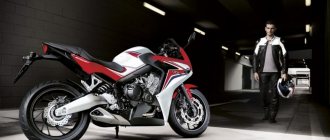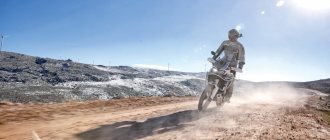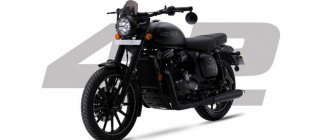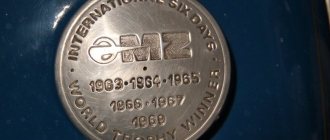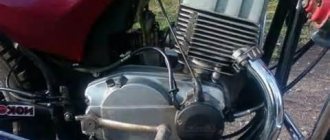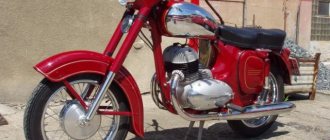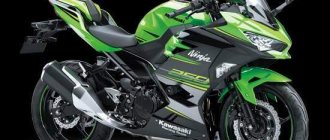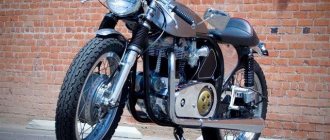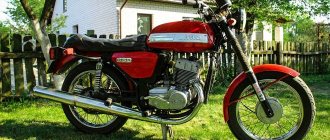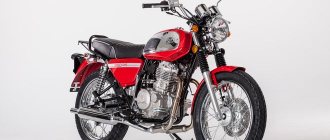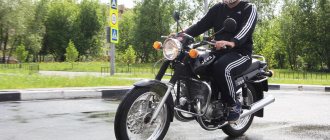The Java 350 motorcycle was created in Czechoslovakia, a now defunct country, and it was actively supplied to another now defunct state - the USSR. Nowadays it is vanishingly rare to see it on the road, but some thirty years ago it was the ultimate dream for many, many motorcyclists. They traveled on it on long journeys throughout the Soviet Union, carefully wiped it with a cloth after the trip, and sometimes even passed it down by inheritance with the words “Keep it as I kept it!” Nowadays they don’t make such impressive technology anymore...
Design
Not a single biker born at least 30 years ago will confuse this model with any other. The recognizable silhouette with an abundance of chrome and a long, flat seat, a seemingly chopped off taillight and matte aluminum engine covers sunk into the soul of many of us even in childhood or adolescence. The Java 350 differs noticeably from Soviet bikes in being less heavy and more graceful.
Specifications
It was not for nothing that Soviet motorcyclists dreamed of this model! The Java 350's technical characteristics are quite good, especially for its time, although now they look hopelessly behind. But this motorcycle was first released almost 40 years ago, and it would be unfair to demand that it meet modern standards.
Engine
The simplest (but for its time - very progressive!) 2-stroke 2-cylinder engine requires gasoline with added oil to be poured into the gas tank so that the mechanisms can be properly lubricated. Power – 26 hp , and this motor is capable of accelerating the motorcycle to a maximum speed of 130 km/h . The two-stroke power unit does not have a long service life, but it is still quite durable.
Transmission
The gearbox does not have 5 gears, as bikers are used to these days, but only 4. But the gear ratios are quite long, so they are enough. And in everything related to reliability, the Java 350 gearbox can serve as a role model for many Chinese defectors, who in the 21st century manage to rivet motorcycles with gearboxes that jam at every tenth shift.
Chassis and brakes
The steel frame with the entire structure described above rests on four standard shock absorbers - two at the rear plus a fork at the front. There are no settings provided, which was the norm for the 80s of the last century. The brakes are also simple, drum, and there is no disc brake even on the front wheel. The braking distance is quite significant, since the bike weighs a lot.
Electronics
a 12-volt battery was used instead of 6. This benefited the motorcycle - its electrical circuit is extremely simple, albeit archaic. Charging of the battery begins when the engine picks up speed from 1000 per minute and above, and is provided by a generator working in conjunction with a diode voltage rectifier. Compared to the previous model of the Czechoslovak plant, the generator has become as much as 2.8 times more powerful.
Weight and dimensions
The dry weight of the bike is quite large, 156 kg without a sidecar. In that era, no one particularly thought about the use of more modern technologies in order to reduce weight and, accordingly, improve power availability. However, compared to many Soviet motorcycles, the brainchild of Czechoslovak engineers does not seem heavy at all.
Controllability
These days, this bike would probably be called a " dual-purpose motorcycle ." It copes equally well with driving both on asphalt and on dirt roads, and even light off-roading is up to it, especially if you take care of purchasing suitable tires. If you compare it not with modern motorcycles, but with those that were produced at the end of the USSR, it will be very good.
Fuel consumption
The Java 350 is capable of running on any gasoline you can find. Don't forget to mix it with oil in a ratio of 40 to 1! And if you change the engine or some elements of the piston group, then the ratio should be 33 to 1, according to the manufacturer’s recommendation. Fuel consumption on the highway can reach 5 liters per 100 km , and in urban conditions it can rise to 7 liters.
New Jawa: three models presented
Do you know where Jawa motorcycles are more popular than in the former Soviet Union and former Czechoslovakia? In distant India! Since the sixties of the last century, two-wheeled cars of the Czech brand were considered very prestigious and super-reliable here. On Indian soil, these motorcycles were produced under license by the Ideal Jawa company from Mysore - first under the original brand, and then under its own Yezdi brand, which came from Slavic languages.
Under the onslaught of Japanese and Chinese products, that company closed back in 1996, but the love for the brand has not gone away without a trace: in India there are still many thematic clubs whose members cherish the iconic Czech motorcycles. Therefore, the Mahindra and Mahindra concern, which took on the development of the huge, world's largest local market for two-wheeled vehicles, tried in every way to include the Jawa brand in its frame.
The Indians were unable to buy out a brand like the Peugeot motorcycle division or the British BSA brand. However, the Czechs agreed to sell a license to use the brand and the classic design of their motorcycles in Asian countries. Two years ago, the Classic Legends company, 60% owned by Mahindra, was founded in India, and work began on new bikes. The result was three new original Jawa motorcycle models, presented at a special event in Mumbai. The first of them is simply called Jawa, the second is Jawa Forty Two, and the third car is the promising bobber Jawa Perak.
The main motorcycle carefully reproduces the appearance of the 353/04 model, known in India as the Jawa 250 Type A. The car has a two-tone, chrome-plated fuel tank on the sides and a chrome-plated engine crankcase, telescopic front forks, a pair of rear shock absorbers, a single disc front brake and a rear drum brake. The single cylinder block and its head have developed ribs, although in reality this is a four-stroke 293 cc liquid-cooled engine with two overhead camshafts. Structurally, it is a twin of the engine of the Mahindra Mojo motorcycle, although the creators claim that they have made significant changes not only in appearance, but also in design. Motor with output of 27.4 hp. and 28 Nm is installed in a duplex frame and is mated to a six-speed gearbox. And on the sides of the motorcycle from the engine there are two chrome-plated exhaust pipes of a classic Java look.
The Jawa Forty Two model is a budget version of the flagship model. If for a “real” Java in India they ask for $2,280, then the Forty Two, without a chrome-plated gas tank, is $130 cheaper. But for this version, six color options are offered (three of them are matte), while the Jawa model can only be black, blue or cherry. Bobber Jawa Perak with one saddle, disc rear brake, 334 cc engine with 31 hp. and a number of other improvements will begin to be released later, but its price has also been announced: $2,600.
Jawa Perak (photo gaadiwaadi.com)
Of course, the new Mahindra Javas will be produced in India itself at the company’s motorcycle plant in Pitgemper. The main competitor will be another classic model - the Royal Enfield Classic 350, which costs only a little less. Orders for the new motorcycles can be submitted on the Classic Legends website from today, and orders will begin to be accepted at 64 existing dealerships on December 5th. Alas, these cars will not be available in Russia: we sell only Czech Javas with Chinese or Italian engines. However, everything may change if Mahindra’s experience with its own Java is successful: the small Czech company is unlikely to be able to resist the Indian industrial giant for long.
Motorcycle price
The cost varies from several tens of thousands of rubles to several hundred thousand , although the latter is rare. This kind of money is usually asked for a bike in perfect condition, in which everything is original, down to the last nut. But just in a living state, it’s quite possible to buy a Java 350 thousand for 20-25 rubles , with documents and at full speed.
Motorcycles “Java” and the Soviet Union. The beginning of the fall
Meeting the Soviet public
By the mid-50s, “Java” was exported to 112 countries. It was then that the USSR government ordered it for its market. As history later showed, this deal became the reason for the subsequent fall of the brand and the concern from the top of Olympus to the bottom of some Tartars.
Expert opinion
Alexander Nikolaevich Rumyantsev
Inventor, owner of many patents, candidate of technical sciences, professor at St. Petersburg Technical University.
But then the prospects seemed most rosy. The Soviet motorcycle enthusiast received at his disposal an incredibly high-quality motorcycle by the standards of domestic production, which was obeyed at a glance, and seemed to be immune to the shitty Soviet roads. It was “Java Perak” that became the catalyst for the emergence of such a public as motorcycle tourists in the USSR.
Well, the concern itself was quite rubbing its hands, as it had gained access to a multimillion-dollar market that was not at all spoiled by quality goods. This resulted in the fact that for almost two decades of production of the “Java” in the Soviet Union, the motorcycle did not undergo virtually any significant changes. The so-called “silent evolution”.
How lack of competition ruined the concern
In the 60s, Japanese products rapidly conquered motor markets around the world. Motorcycles have become much more dynamic, faster, more compact and more stylish.
Jawa 250
And “Java” was more and more oriented towards the Soviet market, since there were no special opponents there. Ultimately, this led to stagnation and a lack of new ideas. As a result, the plant that once thundered throughout the world became no longer needed by this very world. The situation did not change until the collapse of the USSR.
Repair and tuning
All Soviet-era equipment, even imported, is distinguished by its simplicity of design. This is both good and bad. Maintainability in this case goes hand in hand with outdated technologies, which these days are not used even by Chinese and Indian motorcycle manufacturers specializing in extremely low-cost equipment.
Repair
Who will drag Java 350 to the service? Such motorcycles are repaired in the garage, with love and strong words when something doesn’t work out. But seriously, even an inexperienced motorcyclist can understand the design of a Czechoslovakian bike, because it is extremely simple. The wear resistance of some components is low, but they are very easy to repair or replace.
Spare parts
It is very difficult to find original spare parts for a model that was discontinued a long time ago, and you only need to look for it on message boards, owner forums, and so on. They are almost never sold in stores, although there are Chinese analogues of unknown quality. However, they are still not suitable for restoring a motorcycle to its original condition.
Tuning
In the past, this bike was often tuned, especially in rural areas, but now it seems blasphemous. Such motorcycle equipment, which has survived to this day, needs to be carefully restored, and not turned into a traveling exhibit of the “Collective Farm Tuning of the Year” exhibition. And those who do not agree with this, and intend to turn an old Java into a “chopper type” or “sportbike type” with the help of an angle grinder and a sledgehammer, need to be beaten for a long time and thoughtfully with an adjustable wrench until they realize the fallacy of their intentions.
Motorcycle modifications
- Java 350 634 . The first modification to replace its 250 cc predecessor on the production line. Produced since 1973.
- Java 350 638 . The most famous version, produced since 1984. Because of the flat seat, it received the nickname “bench”. In fact, this is a slightly modernized and modified Java 634 6, which was produced a year earlier and was a transitional model.
- Classic Sports . The revived bike was shown to the public at an exhibition in 2015. The appearance has been greatly modified to suit the “cafe racer” style, popular in Great Britain in the 60s of the 20th century.
But rumors about the existence of such models as Java 360 or Java 380 (if we talk about cubic capacity figures) are nothing more than rumors that have been circulating on the Internet since its invention. No such models ever existed, although the old Java 350/360 is sometimes called simply "360", despite the fact that this is incorrect.
Small-scale production of motorcycles was established in Czechoslovakia back in the first decade of the last century, but a new page in the history of motorcycle technology began in 1929, when the owner of the arms factory, Frantisek Janecek, converted it to produce motorcycles. Janecek purchased a license for a 500 cc rear-wheel drive model from the German company Wanderer and released the first basic model of the motorcycle under the Jawa brand. The name of the brand is deciphered quite simply, since these are the first letters of the names of its creators: “Ja” - from Janechek and “Wa” - from Wanderer.The first Jawa motorcycle was not only heavy but also expensive, which is why it didn't excite consumers much. It was necessary to save the situation, and Janecek invited the English designer George William Patchett to develop a new model. Janecek's expectations were justified: in 1932, the lightweight Jawa 175cc Villiers motorcycle was introduced, which quickly gained popularity. Inspired by the success, Janecek began producing 250 cc and 350 cc motorcycles with a four-stroke engine for lovers of powerful motorcycles. In 1937, the debut of one of the most popular models at that time took place - the 100 cc Jawa-Robot motorcycle.
By the end of the 30s, the Jawa motorcycle plant began to play a very significant role in the motorcycle industry of Czechoslovakia, but at the same time another weapons factory, CZ, began producing motorcycles, which began producing 100-, 125- and 350-cc motorcycles with a two-stroke engine. Throughout the war, until 1945, the CZ and Jawa factories were engaged in the manufacture of weapons and repair of equipment for the front. The Jawa motorcycle factory, however, did not give up hope of returning to its main product and even managed to secretly design and test a series of motorcycles, as a result of which the Jawa 250/350 Perak was presented at the Paris Motor Show in 1946. The motorcycle created a sensation as it was an innovative model with a new frame design, hydraulic shock absorbers and a gearbox coupled with automatic clutch release. Two years later, the Jawa-350 with a two-cylinder engine and the Jawa racing motorcycle with a 498 cc engine appeared.
The “golden time” of the Jawa motorcycle plant was in the 50s and 60s, when Jawa models began to be exported to the Soviet Union, which became their main consumer. These were Java-250 and Java-350, well known to Soviet motorsports enthusiasts. The plant became more active in producing racing motorcycles, since thanks to these models the Czechoslovakian team repeatedly won international competitions. The 60s were marked by big changes for the Jawa motorcycle plant, since by government decision the head plant of the Jawa association in Prague was reoriented to the production of semiconductor industry products. For the production of Jawa motorcycles, another enterprise was allocated, which, together with the CZ plant, began to produce unified models. At that time, mainly sports motorcycles were produced for motocross and road racing, and the apotheosis was the Java model released in the late 60s with a four-cylinder liquid-cooled engine.
In the 70s, Jawa motorcycles continued to be actively exported to the Soviet Union and the Eastern Bloc countries. In 1973, mass production of the Jawa-350/634 model began, a road motorcycle with a modernized engine and a new tubular frame. The plant remained true to its sports traditions and in those years produced Jawa sports motorcycles for speedway and multi-day competitions, in which the Czechoslovak team repeatedly became the winner. The beginning of the 80s became the most difficult period for the Jawa motorcycle factory: a new type of classic motorcycle took shape in the West - a model with a four-stroke engine and a piston instead of a disc valve, and Czechoslovak motorcycles turned out to be far from this “ideal”. After the collapse of the USSR, Jawa motorcycles ceased to be in demand in their main market, as a result of which the Jawa parent plant found itself in a critical situation. In subsequent years, attempts were made to modernize the models being produced, but it was not possible to return the former demand for Jawa motorcycles.
Despite this, the Jawa motorcycle factory continued its activities, and in 1987 the 3 millionth motorcycle of this famous brand was produced. In 1997, a new company, Jawa Moto, was formed, which over the past decade has released several models: in particular, Jawa-650 Classic, Jawa-650 Style and Jawa-650 Dakar. The successor to the famous manufacturer of Czechoslovak motorcycles, Jawa Moto, has not forgotten the role that exports to the USSR played in the history of the Czechoslovak motorcycle industry. The company has already announced its intention to resume supplies of Java motorcycles to the markets of the countries of the former Union and intensify their sales. And “Java” will definitely succeed, since there is no need to introduce Java motorcycles to Russian motorcycle enthusiasts.
Advantages and disadvantages
The Java 350 needs to be compared with contemporary motorcycles, and not with models produced today. And for its era, this bike was, without exaggeration, magnificent! It was not for nothing that it was so popular in the USSR, despite the fact that Soviet motorcyclists had to order spare parts for it from the allied Czechoslovakia using various tricks.
Advantages
- Power . All sorts of “Voskhods” and “Izhi” could not compete with the Czechoslovak motorcycle on the road.
- Significant service life of the engine and CPG , noticeably longer than most Soviet bikes.
- Moderate mass , less than that of the Ural or Jupiter.
Flaws
- Difficulty finding spare parts these days. You can find everything, but you have to run.
- Compared to modern competitors, Java 634’s technical characteristics cannot stand any comparison even with the “Chinese”. The 638 model, however, does the same.
- It’s simply a pity to use the completed Java 350 as a vehicle for every day.
Pre-war beginning
Java motorcycles began their history back in the very distant 1920s. Then, in the Czechoslovak town with the specific name Tinetz nad Sazavou, the owner of the concern of the same name, Frantisek Janicek, entered into a deal with the German company Wanderer. It started with the mass production of motorcycles, but now moved on to the production of passenger cars. More space was required in the workshops, so the equipment that had previously worked on motorcycles was put under the knife, so to speak. It was also necessary to sell a whole warehouse of parts and spare parts that had already become unnecessary.
One of the first motorcycle samples
Janicek and his desire to expand his business could not have come at a better time. An agreement was concluded, Frantisek rubbed his hands contentedly. In Europe of those years, the two-wheeled motor companion was in use and in demand. But with the release of the first Java model, all the shortcomings of the deal came to the surface. The production of a motorcycle was expensive, so the price tag on the market was corresponding. But without any clear advantages over its competitors, it failed in sales. In three years, only a little over a thousand copies were sold.
Expert opinion
Isaac Yakovich Zelder
Soviet astrophysicist, physical chemist, Doctor of Physical and Mathematical Sciences, Academician of the USSR Academy of Sciences, designer, engineer. Hero of Socialist Labor of the USSR.
It was necessary to urgently take action to save the newly launched but already drowning motorcycle brand. The name itself, by the way, was invented very simply and no wonder - they took the first letter of the surname of the owner of the concern “Ya” and the first two letters of the German company that sold its technology - “Ba”. They were put together and the familiar “Java” came out.
In order to stay afloat and make a profit, it was decided to reduce the speed a little and produce simpler models. As a result - the “Java Robot” motorbike. It was he who allowed it to gain popularity in the European market. It was simple in design, relatively inexpensive, and because of its classification, there was no need to obtain a license or buy a license plate. In the first year, more copies were sold than the first “Java” for the entire period of its release. In total, about 15 thousand copies were purchased before the war.
Owner reviews
In my youth there was such a device, I don’t remember the year of manufacture, I never had any documents, but I drove it in the 90s, and even then it was far from new. With Java, I was always the first guy in the village)) This is not Minsky with Voskhody... The horse is fire! On the highway it can easily go over a hundred, but if desired, it can also rush along an intersection normally if the tires are adequate. As far as I remember, it didn’t break much, except that the carburetor had to be adjusted again from time to time, something was wrong with it. But still, the spendthrift is a legend! Arthur, Nizhny Novgorod.
Last year I bought myself an old Java for restoration, the seller gave me 634 not running as a load, so I’m doing a little of both. The old woman is already on the move, I’m slowly finishing 634, bringing it to mind. It’s difficult to find original spare parts, but I don’t want to install non-original ones, the goal is to restore it to collectible condition. I am pleased with the very simple and well-thought-out design; compared to modern motorcycles, the difference is huge. Evgeny, Lipetsk.
I still ride this motorbike; it is parked at the dacha and spends the winter there right in the barn. In the city of Golda-poltorashka there is, 180 km to the dacha, but there are no asphalt animals around there at all, the goldolet on local roads is only ruined, so I drive there in Java when I arrive. The moped is indestructible; after wintering in a snow-covered shed, it always starts, you just need to charge the battery and throw in fresh gas. Previously, they knew how to make real equipment)) Dmitry, Ryazan.
Motorcycle Jawa 350 OHC Prima: deliveries to Russia begin
During the Soviet Union, every boy's dream was a Jawa motorcycle - and always red! Although there were other color options in the range of the Czech plant. But in those days when Japanese and European motorcycles could only be seen in pictures, the red Jawa was considered almost a model of perfection for Soviet motorcycle enthusiasts.
Do you think Jawa, along with other motorcycle factories of the former socialist camp, has long since fallen asleep? Nothing happened! Founded in 1929, the brand still produces motorcycles, although only memories remain of its former glory. The privatized company was divided into two: Jawa Divišov deals with racing equipment, and Jawa Moto from the town of Tynets nad Sazavou produces motorcycles for public roads.
Moreover, road Javas can still be bought in Russia! The most affordable Jawa 350 Premier with a two-cylinder two-stroke engine with a power of 23 hp, a kickstarter and a separate lubrication system is estimated at 230 thousand rubles, and for the top model Jawa 660 Sportard with an engine from the Italian company Minarelli (49 hp) they ask for as much as 540 thousand!
Jawa 350 OHC
However, our market has long ceased to be a priority for the Czech company: Java is now sold mainly in Latin America. After all, motorcycles with two-stroke engines are barred from entering Europe, while cars with Italian four-stroke engines are expensive. Therefore, for the Old World, the Czechs have prepared a new version with a Chinese Shineray four-stroke engine that meets modern standards. The motorcycle is called Jawa 350 OHC, where the gas distribution system is encrypted in the letter index: overhead cam - upper camshaft. And the crafty number 350 again reminds us of the popular Jawa 350/634 model of 1974, although in fact the displacement of the Chinese engine is 397 cubic meters, and the unit itself largely copies a similar Yamaha engine. The output in the Euro version is 27.7 hp. and 30.6 Nm.
Jawa 350 Replica
The motorcycle with a retro appearance is equipped with ABS, weighs 160 kg and costs 99,930 crowns in its homeland, that is, approximately 3,750 euros. The Russian importer of Java also announced the start of deliveries of this model. True, the price is biting: our Jawa 350 OHC Prima is estimated at at least 375 thousand rubles. Moreover, sellers require full prepayment: the first half of the amount must be paid when ordering, and the second - when shipping the car from the Czech Republic. Interestingly, the Jawa 350 Replica model with the same appearance and a 23-horsepower two-stroke engine will cost significantly less - from 290 thousand rubles.
Similar models
- Izh Planet 5. An excellent motorcycle for its time, quite powerful and unpretentious.
- Izh Jupiter 5. The characteristics are similar to the above-mentioned brother, but differs from it in having a 2-cylinder engine instead of a 1-cylinder.
FAQ
- Do the spare parts for 634 and 638 fit together? For the most part, yes. But parts for a more recent model, that is, 638, are more often found on sale.
- How many horses are there in Java 350? Exactly 26 fast horses. True, no one remembers exactly how the Czechoslovak plant measured power, at the crankshaft or at the rear wheel.
- I have an old anniversary car in my garage, I got it from my grandfather, it hasn’t started for about twenty years, but it looks decent. Does it make sense to invest in restoration for the purpose of selling? Yes, if the bike is in overall good condition. Collectible pieces can be quite expensive.
- What is the lifespan of this motor? There is no exact data, but there are reviews from owners who claim that the engine runs 30,000 km or more without repairs.
- How much does the Java 350 motorcycle weigh? Curb weight with all fluids and other things is about 185 kg, dry weight is about 156 kg.
Conclusion
Comparing the Jawa 350 motorcycle with modern bikes is incorrect and even unfair. In terms of technical characteristics, this model, developed half a century ago, is inferior to any motorcycle that can be bought in showrooms now, even Chinese. But for their time, the Czechoslovakian steel horses were magnificent, and many motorcyclists have the warmest memories of them. If, when you look at this recognizable silhouette, nostalgia rolls over you, and you want to lock yourself in the garage and start servicing this greeting from the last century, then it’s worth buying it to pamper yourself. The completed Java 638 will become not only an excellent toy for real men, but also just a good weekend motorcycle.
Specifications
| Maximum engine power: | 26 HP |
| Working volume: | 350 cm3 |
| Motor type (cylinder arrangement, number of strokes): | 2-cylinder, 2-stroke |
| Number of cylinders: | 2 |
| Number of valves: | |
| Intake type (Injector / Carburetor): | |
| Bore and stroke: | |
| Starting system (Electric starter, kick starter): | |
| Maximum speed in km/h: | 130 km/h |
| Cooling system: | Air |
| Transmission (gearbox): | 4-speed |
| Clutch (Dry / Wet): | |
| Drive unit: | Chain |
| Frame: | Steel tubular |
| Chassis | |
| Suspension (front/rear travel): | |
| Brakes (Front/Rear): | |
| Wheels / Tires / Rubber: | |
| Dimensions and weight | |
| Dimensions (Length / Width): | |
| Seat height: | |
| Ground clearance: | |
| Curb weight: | |
| Wheelbase: | 1335 mm |
| Weight: | 156 kg |
| Fuel tank capacity: | 17 l. |
| Battery capacity: | |
| Year of release: | |
| Country of Origin: |
